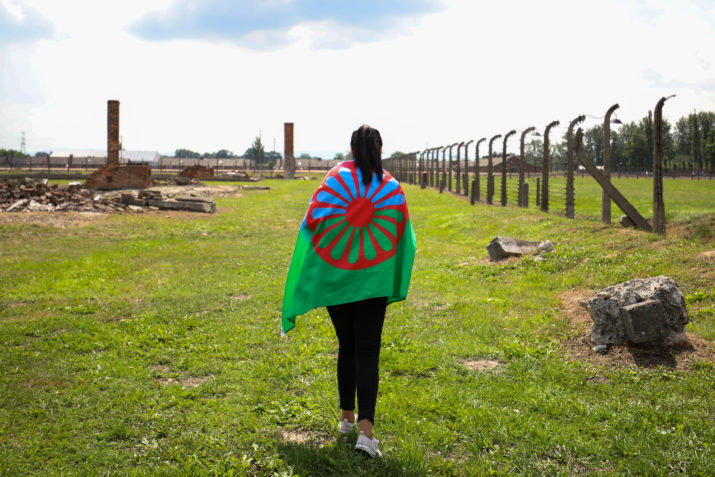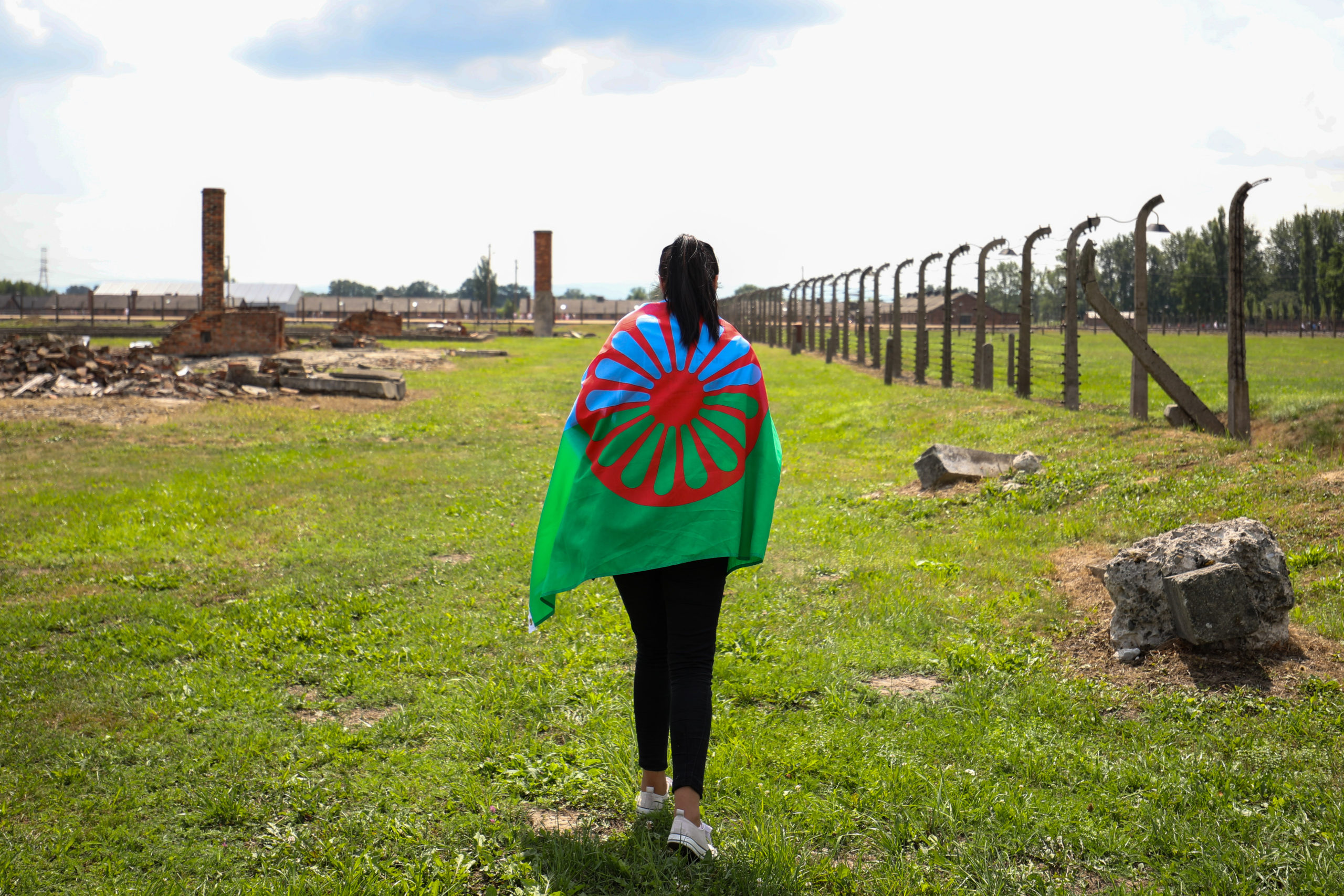

This is part of a Roundtable, Ideas of Race, Ideologies of Racism: Roma Rights in Europe during the #BLM moment.
COVID-19 laid bare the health inequalities and gaps in access to care among marginalized communities in the United States and Europe. When George Floyd died at the hands of law enforcement in May 2020, twin crises arose exposing some of the many generations-long challenges of simply existing as a Black person in the United States. As the most visible organization advocating for the rights of Black lives through protest, Black Lives Matter (BLM), has become synonymous with the contemporary movement for racial justice and equality. Support for the organization has been transnational, transgenerational, multiracial, and multiconfessional; and it has offered a possibility to articulate a shared struggle among various populations defined by their marginalization broadly and, in some cases, their Blackness specifically. For a few weeks in May 2020, a racial reckoning appeared to be on the horizon as the entire western world took note collectively (for what felt like the first time since the Civil Rights movement of the 1960s) of the systemic racial violence embedded in US systems of power. For many of us who are racialized as Black, we wondered what was unique about this moment and where our fellow citizens, the international community, and even our academic fields had been when so many others had been killed before in such strikingly similar ways. Nevertheless, this moment seemed different. There was a palpable urgency, collective mourning, and members of majorities showing solidarity with what for many has been and continues to be a daily struggle.
Throughout the spring and summer months of 2020, BLM solidarity marches sprang up in Canada and throughout Europe—particularly in West European states where Black people constitute a measurable percent of the population. In these seats of former empires, there were thousands (in some cases tens of thousands) of people who participated in these marches. Like those in the marches and protests in US and Canada, participants in European spaces demanded equality for Black lives, increased awareness of their systemic marginalization, and recognition of the generational impact of colonialism on the perpetuation of racial hierarchies there. BLM solidarity marches took place in Central and Southeast European countries. In Budapest, Podgorica, Belgrade, Pristine, Sophia, and Zagreb, people belonging to diasporic African communities marched with majorities to assert that Black lives matter. A number of local media outlets covered the marches, one of which featured a woman at the Podgorica protest who stood with a sign in English that read, “Prejudice against Roma People is also Racism.” With this one sign, the contradictory nature of the marches was apparent: many people in capital cities in Eastern Europe stood in solidarity with the BLM movement, but not for Roma members of their local populations who have likewise suffered generationally from systemic racism. The protesters failed to acknowledge that “all Black lives matter” (Skenderi 2020). Well-known Montenegrin musician and performer Rambo Amadeus offered similar commentary:
It is not possible to judge racism in the Balkans on attitudes towards Blacks. We don’t have Blacks here. Racism is measured by our treatment toward our Roma brothers. How many of them do you personally know? With how many of them are your friends? (2020)
Of course, there are Black people in the Balkans, but their numbers are fairly insignificant in comparison to other minoritized populations. BLM marches provided a context to support Central and Southeast European Romani communities, but this did not happen, and the moment has passed. Why this did not happen is worthy of analysis.
It is possible, if not logical, to simultaneously support Black and Romani lives, as the groups possess commonalities. Both groups are diasporic, and presumably most members of these communities have never known the privilege of a life without racism, be it the systemic forms that affect daily existence or individuals acting against them on prejudices that are normalized in their societies. Both communities carry with them a distinct “twonesss,” or the feeling that members of the majority population imagine them as Other, which heightens the awareness of difference in the one who is raced. While the twoness of the color line is not the only factor in the European context and “passing” exists as an assimilatory strategy for some (Horváth 2010, 123-130), race manifests in ways that are specific to the cultural context in which it is produced, rendering “twoness” adaptable. Stereotypes and prejudices surround Romani communities; and it is in these stereotypes that racist rhetoric and violence are based. “Twoness,” of double consciousness as addressed by Du Bois (1903), or dueling consciousness as articulated by Ibram Kendi (2019), are inherent to the experience of members of raced communities. These concepts are foundational to understand race as not just an active category, but an ongoing process affecting many marginalized communities, including those broadly grouped or considered to be Roma.[1]
While it is a norm in and outside of the United States to speak of Black Americans as defined by race, it remains a challenge to express similar sentiment about Roma, who are frequently referred to as an ethnicity and not a race. However, ethnicity does the work of race as it normalizes certain groups and marks others. Colorblindness in Europe has rendered race no longer a valid category of analysis, but it must be stressed that race is “never one thing” (Goldberg 2006, 8). Race “is a practice… a mechanism for shifting and classifying the world” (Lentin 2020, 33). It distinguishes white and non-white by “law or by custom” (Mills 2014, 14), so that who belongs to which group is based on societal norms. Whereas “race” as a category and the actions of “racism” in European contexts were believed by many to have been subsumed in the language of “multiculturalism,” “integration,” and “democracy,” race simply became a more “abstract signifier separating human groups socially, politically and economically” (Lentin 2008, 490). While it is now possible to presume that we have moved beyond the biological racism that undergirded European colonial constructions of the worth of bodies, the meanings attributed to race and its mechanisms are mutable and have changed accordingly. Given this reality, we must move beyond the idea that race is a collection of individual acts of bias or solely a social construct, and advocate for examining race as a lived experience. Understanding the “facticity” (Lentin 2020, 26) of race and its situatedness as an experience and its genealogies help to explain how and why race functions to marginalize groups similarly in disparate contexts. Its forms have become more coded, potentially more pernicious, and embedded, as the mechanisms of difference have become entrenched.
Similar to Black Americans, members of European Romani communities are marginalized in their countries of birth. Their lives are subject to violence and injustice, which impact their interactions, expectations, and even health outcomes. In short, they are subject to the necropolitics of their states. The nature of systemic racisms means that these challenges can affect members of Romani communities irrespective of their educational attainment, wealth, or experiences. Roma, like African Americans and other marginalized groups in the world, are experiencing complications from COVID-19 to a greater extent than majority communitiesand loss of livelihood because of the racialized nature of “essential” work (EUAFR 2020)
Romani communities are also becoming targeted as agents of contagion, enlivening problematic historically racist paradigms (Matache and Bhabha 2020). In the European Union, Bulgaria, Romania, and Slovakia communities with significant Romani populations were put in lockdown in the early months of the COVID-19 pandemic as a “precautionary measure” despite a lack of confirmed cases (EUAFR 2020). This is exacerbated by disinformation campaigns intentionally spreading false information about Romani communities and their possible connection to COVID-19 (Korunovska and Jovanovic 2020). This “ethnitization of the pandemic” (Rorke and Lee 2020) precipitates racist acts directed against Romani communities including unwarranted surveillance and policing to prevent movement (Korunovska and Jovanovic 2020). are falling ill and dying from COVID-19, but the exact rates at which this is happening are unknown because of a lack of race-based data owing, presumably in part, to the legacy of race as an inactive category throughout Europe (Waldersee 2020). In European contexts, the quest to eschew race has led to advocacy for integration and color blindness, based on the putative inherent similarities among various peoples. However, the logic of integration is itself a form of erasure as it fails to recognize difference among groups of people and individuals and is “unidirectional” (Lentin 2018, 490). It normalizes assimilation and the universality of the majority. In the context of disparities, the absence of race-based data renders these important differences invisible.
In 2016, when I first began research and writing on Romani communities in Eastern Europe, I did so with an eye toward the comparative and relational racialized experience(s) of African Americans and Romani communities in Eastern Europe. As a Black woman specializing in Central and Southeast Europe, the parallels were clear; however, I had a great deal of work to do to move from perceptions to informed arguments. There were many questions that people, primarily Europeans, asked of me: How, they asked, did African Americans already have Martin Luther King, the Black Panther Party, Black Lives Matter, and Barack Obama? How did it become possible for people to not be afraid to say, “Black lives matter?” They confirmed at multiple conferences that it would be unlikely that majorities in Central and Southeast Europe would ever say “Roma lives matter.” At the time, Barack Obama was president and, despite the emergence of BLM in response to the killing of innocent Black women, men, and children, it felt that Black Americans were reaping the benefits of the generations that fought hard for liberation and a recognition of our humanity. However, with this uplift came a difficult and painful fall. As millions of American citizens voted in the 2016 presidential elections, and the Electoral College endorsed the selection of a minority of voters, Black Americans felt the generations of racial progress swept away in an election. Regarding European Roma, similar fits and starts of inclusion and recognition are similarly observable: courtroom victories in desegregation were negated by resegregation practices and ineffective and failed EU and Council of Europe directives focused on Romani inclusion strategies were effectively undone or unrealizable because of entrenched racism and prejudice.
It turns out that what felt like a racial reckoning, was only a moment that, like so many others, passed. Rage swelled, but soon subsided as attention directed toward tolerance and racial justice faded from the collective, was lost, or was directed elsewhere. As George Floyd was killed at the hands of law enforcement, there were others who shared his same fate, but there were no significant global protests aside from quick mentions on news reports and hashtags that faded from collective memory as new names took their places. These facts are consistent among Romani communities: their communities are deeply affected by COVID-19 and Romani men and women have been harassed, attacked, and killed at the hands of law enforcement with little recognition of the systemic nature of these actions (Rorke and Lee 2020). Europe as a whole, just like the United States, is facing twin crises, and race is implicated in both. It is time to say “Roma lives matter,” with the call to equity and affirmation of life that the BLM movement advances and apply this sentiment to local contexts for more than a moment. If it is possible to say “Black Lives Matter” in contexts where the use is primarily a simulacrum in its call to support a symbolic Black community, it is necessary to say, mean, and act upon the fact that Roma lives matter.
Sunnie Rucker-Chang is Assistant Professor of Slavic and East European Studies and Director of European Studies at the University of Cincinnati. She works, writes, and teaches primarily on racial and cultural formations and minority-majority relations in Southeast Europe. She is the co-author of Roma Rights and Civil Rights: A Transatlantic Comparison. She is also finishing a monograph tentatively titled “Discourses on Blackness in Yugoslavia: Legacies and Dimensions of an Idea” that challenges conventional ideas of race and racialization in the Balkans and connects the region to broad trends in European Studies.
References:
Du Bois, W. E. B. 1903. The Souls of Black Folk. Chicago: A. C. McClurg & Co.
European Union Agency for Fundamental Rights. 2020. “Coronavirus Pandemic in the EU –Impact on Roma and Travellers.” 1 March – 30 June 2020. September 20, 2020.
Goldberg, David Theo. 2006. “Racial Europeanization.” Ethnic and Racial Studies 29 (2): 331-364.
Horváth, Kata. 2010. “’Passing’: Rebeka and the Gay Pride: On the Discursive Boundaries and Possibilities of Skin Colour” In Multidisciplinary Approaches to Romani Studies, edited by Michael Stewart and Márton Rövid, 123-130. Budapest: Central European University Press.
Kendi, Ibram. 2019. How to be Antiracist. New York: Penguin Random House Books.
Lentin, Alana. 2020. Why Race Still Matters. Cambridge: Polity Books.
Lentin, Alana. 2008. “Europe and the Silence about Race.” European Journal of Social Theory 11(4): 487-503.
Matache, Margareta and Jacqueline Bhabha. 2020. “Anti-Roma Racism is Spiraling during COVID-19 Pandemic” Health and Human Rights Journal, April 7, 2020.
Meadows-Fernandez, Rochaun. 2018. “Even as Black Americans Get Richer, Their Health Outcomes Remain Poor.” Pacific Standard. January 23, 2018.
Mills, Charles. 1997. The Racial Contract. Ithaca: Cornell UP.
“Rambo Amadeus: Rasizam na ovim prostorima ne mjeri se odnosom prema crncima, nego prema Romima.” 2020. Oslobođenje, June 7, 2020.
Rorke, Bernard and Jonathan Lee. 2020. “Roma Rights in the Time of Covid.” Brussels: European Roma Rights Center.
Skenderi, Isak. 2020. “All Black Lives Matter” Kosovo 2.0, August 6, 2020.
Waldersee, Victoria. 2020. “COVID Toll Turns Spotlight on Europe’s Taboo of Data by Race” Reuters, November 19, 2020.
[1] I use the ethnonym Roma in this essay with recognition that there is not one Roma community, but rather, many Romani communities with their own histories and culture.
Photo: European Roma Holocaust Memorial Day-75th anniversary of the liquidation of Zigenerlager in KL Auschwitz-Birkenau | Shutterstock




